 |
: January 2005 |
||||||||
| To Laurence, traditional music enthusiast who help some Russian children to rediscover their traditional whistles. To Rolf, for the invaluable information that he sent me.
Discoverery context: For this New Year, this whistle was found in France displayed hastily on the pavement. General description: This whistle is a horsewoman with a large hat. The figurine rests on a tripod and the back of the horse is a conical whistle. The whistle is in average state with several chips. The ears of the horse are broken and the red color of the woman's coat is fadded. It measures 3.6 inches length, 4.5 height and 2.3 large. The decoration: The whistle is made in a dark red clay covered with a white base. The body of the horse is decorated with bands of circles: yellow circles pointed of black or red circles on yellow features. The woman carries a red coat and a dark green hat. Traces of gilded spots remain on the hat. | 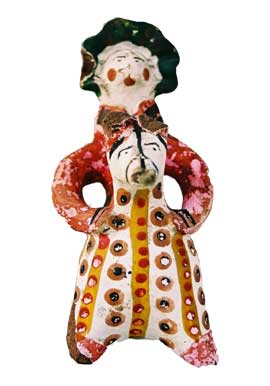   |
||||||||
| Study of the object
Typology: It is a globular whistle. A playing hole on each side of the horse makes it possible to play a third and a fifth (D, F#, B). Analyze: The attribution of this whistle isn't a problem as it is so characteristic of the production of Dymkovo. Many books were written about the production of clay toys of this village which became the emblem of the Russian production of clay toys in the whole world since the beginning of the 20th century. Many other centers exist in Russia but the coloured toys of Dymkovo are so varied and really symbolize the Russian folk art. |
|||||||||
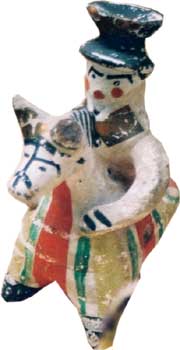 Rider End 19th Beginning 20th S. old collection of musicology of the Museum of the Man. Paris |
Dymkovo Dymkovo, government of Viatka, is located in the north of Russia near the town of Kirov (former Khilnov until 1781, then Viatka until 1934).
The whistles of Dymkovo are associated with the festival of the whistles Svistounia (the whistle dance) (read the popular traditions ). Production: About 60 families of toy-makers were living in Dymkovo in 1856. They sold about 20 to 25000 toys a year. From the 1850s, the production declined. In 1871, only 16 families were engaged in toy-making year around. For the others it was only a seasonable production. During the 1st World War, only Anna Mezrina still modelled the clay figurines. The moulded plaster-of-Paris statuettes flooded the market and were more profitable. It is after the October Revolution (1917) that the State helped the production and opened a workshop in the 1930s in the factory of plaster-of-Paris knick-knacks. The workshops were then integrated into the USSR art Fund and the best artists joined the USSR Artists' Union. The production falled in the 1950s. The preparation of clay was centralized and a synthetic pigment succeeded the artisanal white color. The traditional pigments were replaced by the gouache. The toys had a shining aspect far away from the old models. Today the new generation makes again the traditional models. There is no many whistles and the figurines or the groups of figurines are in a large majority. About 40 girls and women work in the creative union "Dymkovo toy folk art handicraft" nowadays.
| ||||||||
| The traditional manufacturing process:
The red clay was mixed with the river sand to avoid cracks while baking. Then clay was cleaned and mixed until it is plastic and rolles out into "pancakes" from which the figurines were shaped. One manufactured initially the skirt and the trunk on which one fixed then the spherical head and the arms before smoothing the figurine with the wet fingers. The figurine was left several days to dry before being baked in the traditional oven in large batches (up to 3000 to 4000 pieces) during 3 to 4 hours. After cooking, the toys were dipped into a mixture of skimmed milk and chalk forming a bright white scum all over the red clay. The toys were then covered of geometrical decorations and circles with pigments mixed in egg yolk and kvas (rye alcohol). The basic colors are the red, the yellow, the blue, the black and sometimes gold. A woman with two children was able to realize thus from 100 to 200 figurines and 100 to 200 whistles per day.
No doubt that the whistle of the month was made before the 1950s using these traditional methods. But who was its author?
| 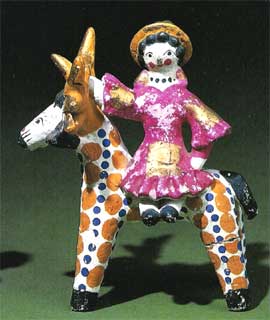 Rider H: 6.9 inches E Kochkina 1940 Museum of Ethnographie Saint Petersburg |
||||||||
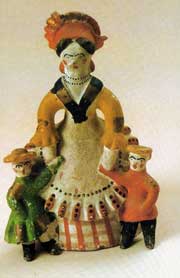 Nurse End 19th Beginning 20th S. Anna Mezrina Museum of ethnology. St Petersbourg |
Artists.
It's not obvious for a non-specialist to recognize the style of the artists who made whistles before 1945. It seems that the decorations of the whistles of the late 19th and beginning of the 20th century were simpler with less geometrical patterns. A two heads horse in the Saint Petersburg museum was acquired in 1935. It has the same pattern as the horse of our whistle. The woman's cap and her costume point out others figurines made between 1925 and 1935. One can thus date the whistle between the 1900s and the 1930s. At this time, only a few artists produced such whistles. Anna Mezrina (1853-1938): She is the most talented and famous within the artists of the 20th century. Daughter of a local blacksmith, she learnt how to make toys from her mother.
Alexandra Mezrina (-1934): Anna's daughter has worked with her mother until 1934 and her style isn't easily differentiable. |
||||||||
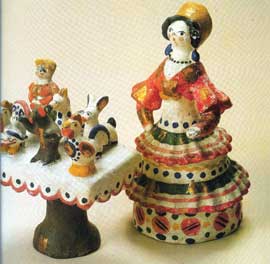 saleswoman of toys Modelled E Penkina 1944; painted by E Kos-Denshina Russian Etnographic Museum in Saint Petersburg |
We must also quote: E. A. KOSHKINA (1871-1953): The museums have many specimens of her production of the 1930s-1940s. Zoya Penkina (1897 -): Maria Laletina (): It is difficult to choose between these artistes. Only Anna Mezrina's style has probably to be excluded because her decorations were more spontaneous. In fact, it is preferable to leave the whistle of the month without attribution . |
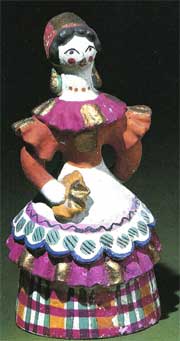 Woman. H: 7.9 inch E Kochkina 1940 Russian Etnographic Museum in Saint Petersburg |
|||||||
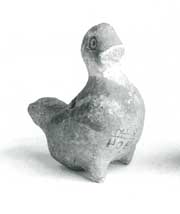 Bird whistle, slip 15-16th century found in Moscow Historical National museum. Moscow |
The typology of the other whistles of Dymkovo:
Before the 19th century, no model is known but the old Russian whistles near Moscow had the same typic tetrahedron shape. The standard shapes of Dymkovo can be seen in the other Russian pottery centers.
| 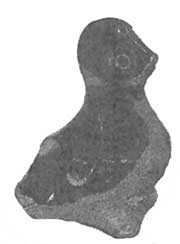 Bird, green Glaze between the 16 and 18th century 5.6 x 3.8 x 2.8cm found in the citadel of Kolomenskoye, Moscow area Zogorsk Toys Museum |
|||||||
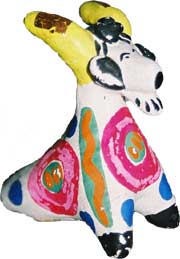 Goat E A Perminova End 20th C. |
|||||||||